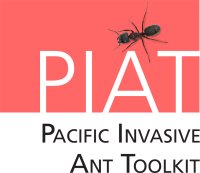Non-toxic options
Please note that if the pest ant you wish to treat is the little fire ant or red imported fire ant you should not attempt the following options but SEEK HELP IMMEDIATELY.
Non-toxic options are preferred by people who wish to avoid the potential risk of non-target effects altogether.
Often these options require more effort, but they are cost effective.
Keeping things clean : Salt water dousing : Hot water treatment : Further information : A note on boric acid treatment
Keeping things clean
| The number one thing you can do to make ant problems less painful is to remove resources e.g. nesting materials, food scraps, treatment of the plant pests that are helpful to ants. Sometimes wiping the ants away with a damp cloth can get rid of ants that are foraging (e.g. in kitchens). If you wipe away any ants that you see for a few days they should stop coming in. This probably works because other ants notice the smells of their dead nestmates and / or it disrupts their foraging trails. Either way the ants realise the area is not safe. Yes, ants are that smart! Another good, simple method is mixing a little dish washing liquid and water in a squirt bottle and spray. The fatty acids in the detergent will get rid of the ants. |

Rubbish piles provide a fantastic source of food and nesting locations for invasive ants (© Monica Gruber, Pacific Biosecurity) |
You can also treat infested plants by recycling the water you used to wash your dishes in – simply pour the used water on plants. This treatment will also stop aphids, scales and mealybugs, and therefore the ants that might be 'farming' them.
PestNet has a comprehensive range of resources for managing pests. You can browse PestNet for factsheets and other information. These factsheets are particularly useful to find out how to deal with mutualists of ants, such as mealybugs.
Do not plant Hibiscus near the house as it is a major attraction for ants.
Salt water dousing
Salt water dousing involves looking for the ant nest and destroying it (i.e. targeted treatment of nests with salt water dousing).
The idea is to follow the worker ants back to the nest entrance and flood the nest with salt water.
This forces the queens out of the nest. It is important to to stay and wait for the queens to leave and kill them directly. Queens are very good at escaping and hiding so you need to look carefully. The nest and surrounding area needs to be checked over the following few days and re-treated if necessary.
Note that if the nest isn't effectively destroyed remaining queens and workers can leave the colony by budding.
It is important to note that all control methods require regular site visits and repeat of the control method. This is because the presence of invasive ants throughout the landscape means that sites left untreated will be recolonized.
Dousing with salt water is a very labour intensive method, but an option if there aren't any others.
Hot water treatment
Hot water can be used to kill entire colonies of ants if a large enough volume of hot water is applied directly to the nest (using a large kettle for example). Water temperature should be above 65°C (and ideally above 82°C) to be lethal to the ants.
Precautions must be taken with hot water methods to avoid burns. This treatment must never be undertaken around children.
The volume of water applied will depend upon the size of the nest. For very small colonies 4 L of water may be sufficient. For larger colonies as much as 75 L of hot water may be necessary to reach the below-ground nest structure and kill all of the ants.
Water can be applied by pouring into the nest after opening the above ground structure with a long stick or rod to assure that the water flows below-ground and does not just wash away the mound on the ground surface. Alternatively, water can be injected below-ground if a hollow wand or tube is available to deliver the water.
Hot water treatment, if delivered below-ground, at high enough temperature, and sufficient volume, will be immediately lethal but nests should be rechecked for activity and retreated after the initial treatment (within 2-3 weeks) if additional activity is detected. For control of individual nests, hot water treatments offer a rapid, entirely non-toxic alternative for problem mounds. In the case of fire ants, apply the hot water directly to the mound.
As with other methods hot water treatments require regular site visits and repeat of the control method. This is because the presence of invasive ants throughout the landscape means that sites left untreated will be recolonized.
For locating the nests of other invasive ant species, whose nests are not so obvious, follow workers back to their nest. Be sure to watch out for the queen leaving the nest. If you fail to kill the queen, she will simply make another nest nearby.
Further information
This article from Tips Bulletin covers 8 useful natural ant remedies.
Wikihow has information on spraying / wiping with vinegar / lemon juice solutions, soapy water.
A note about boric acid based treatments
Treatments using boric acid are often called non-toxic. However, the boric acid can accumulate in the environment and have non-target effects. Boric acid treatments are also not as effective as other treatments.
Information sources
Information on hot water treatments was provided by Josh King, University of Central Florida, joshua.king@ucf.edu
Technology transfer UCF, Simple solution for exterminating fire ants
content reviewed by Viv van Dyk, FBA Consulting, July 2017
